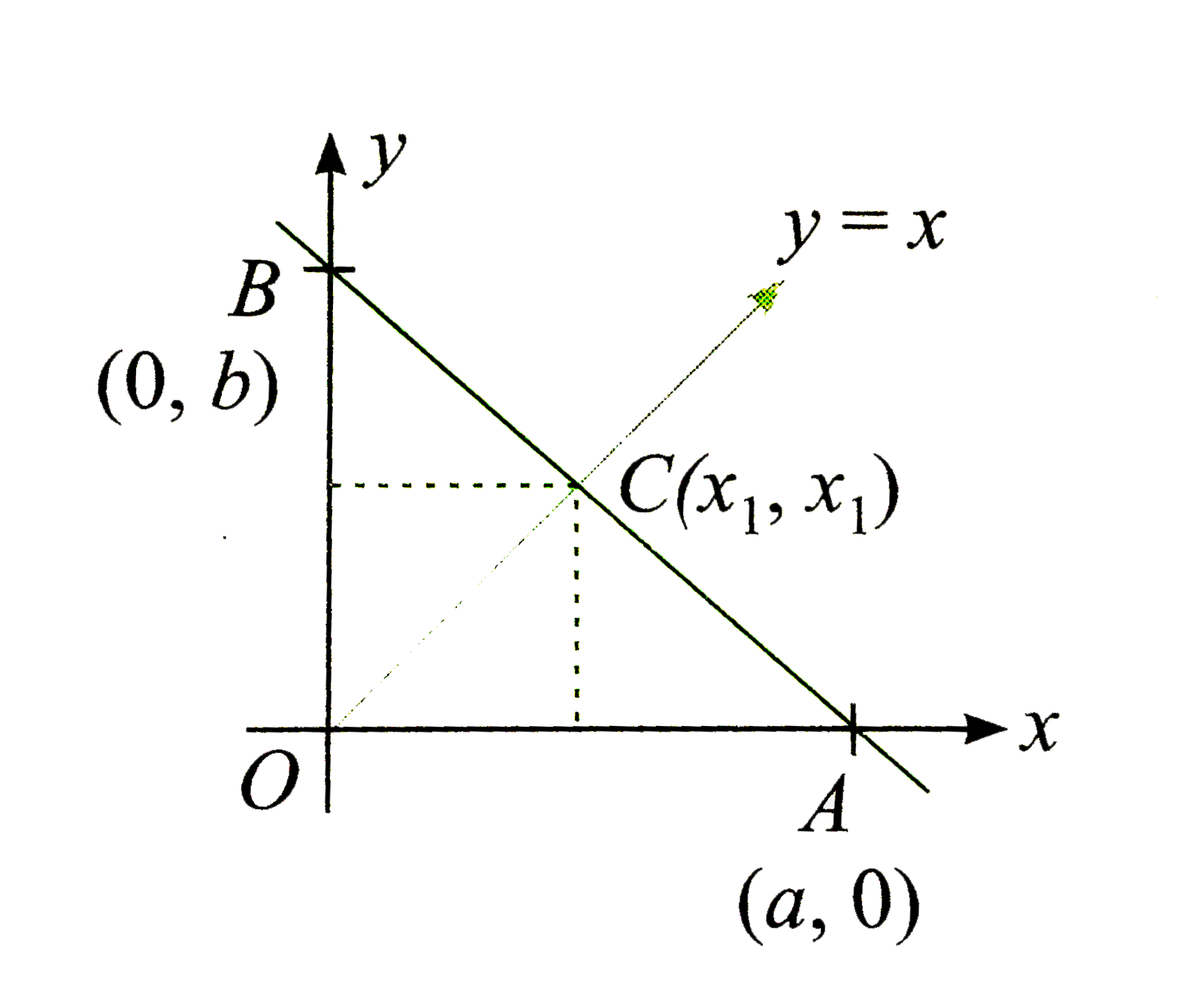The line xa+yb=1 meets the x-axis at A, the y-axis at B, and the line y=x at C such, that the area of DeltaAOC is twice the area of DeltaBOC . Then the coordinates of C are (b3,b3) (b) (2a3,2a3) (2b3,2b3) (d) none of theseSolution in Tamil
(b3,b3)
(2a3,2a3)
(2b3,2b3)
none of these
The correct Answer is:C

Given arΔAOC=2(arΔBOC)
or12(OA)(x1)=2×12(OB)(x1)
or a=2b
The equation of AB is
xa+yb=1 (1)
or x2b+yb=1 (2)
Since point C lies on line (2), we have
x12b+x1b=1
or x1=2b3=a3
or C≡(2b3,2b3)
Topper's Solved these Questions
- BOOK - CENGAGECHAPTER - STRAIGHT LINESEXERCISE - Exercise (Multiple)30videos
STRAIGHT LINES
- BOOK - CENGAGECHAPTER - STRAIGHT LINESEXERCISE - Exercise (Comprehension)27videos
STRAIGHT LINES
- BOOK - CENGAGECHAPTER - STRAIGHT LINESEXERCISE - Exercise 2.65videos
STRAIGHT LINES
- BOOK - CENGAGECHAPTER - STRAIGHT LINEEXERCISE - Multiple Correct Answers Type8videos
STRAIGHT LINE
- BOOK - CENGAGECHAPTER - THEORY OF EQUATIONSEXERCISE - JEE Advanced Previous Year9videos
THEORY OF EQUATIONS
Similar Questions
If P is a point (x,y) on the line y=−3x such that P and the point (3, 4) are on the opposite sides of the line 3x−4y=8, then x>815 (b) x>85 y<−85 (d) y<−815
03:07View SolutionLet L be the line belonging to the family of straight lines (a+2b) x+(a-3b)y+a-8b =0, a, b ∈R, which is the farthest from the point (2, 2).
Area enclosed by the line L and the coordinate axes is02:12View SolutionIf aandb are two arbitrary constants, then prove that the straight line (a−2b)x+(a+3b)y+3a+4b=0 will pass through a fixed point. Find that point.
03:37View SolutionThe point P(α,α+1) will lie inside the triangle whose vertices are A(0,3),B(−2,0) and C(6,1) if
04:13View SolutionQ. Let p and q real number such that p≠0,p2≠q and p2≠−q. if α and β are non-zero complex number satisfying α+β=−p and α3+β3=q, then a quadratic equation having αβ and βα as its roots is
04:06View SolutionThe line xa+yb=1 meets the x-axis at A, the y-axis at B, and the line y=x at C such, that the area of DeltaAOC is twice the area of DeltaBOC . Then the coordinates of C are (b3,b3) (b) (2a3,2a3) (2b3,2b3) (d) none of these
04:39View SolutionProve that: ∣∣ ∣∣a−b−c2a2a2bb−c−a2b2c2cc−a−b∣∣ ∣∣=(a+b+c)3
05:26View Solutionसिद्ध कीजिए कि
∣∣ ∣∣a−b−c2b2c2ab−c−a2c2a2bc−a−b∣∣ ∣∣=(a+b+c)302:51View SolutionShow that ∣∣ ∣∣a−b−c 2a 2a 2bb−c−a 2b 2c 2cc−a−b∣∣ ∣∣=(a+b+c)3
04:37View Solutionদেখাও যে,
⎡⎢⎣2aa−b−c2a2b2bb−c−ac−a−b2c2c⎤⎥⎦=(a+b+c)304:32View Solutionसिद्ध कीजिए कि
∣∣ ∣∣2a2aa−b−c2bb−c−a2bc−a−b2c2c∣∣ ∣∣=−(a+b+c)302:03View SolutionThe line xa+yb=1 meets the x-axis at A, the y-axis at B, and the line y=x at C such, that the area of DeltaAOC is twice the area of DeltaBOC . Then the coordinates of C are (b3,b3) (b) (2a3,2a3) (c) (2b3,2b3) (d) none of these
04:39View Solutionprove that ⎡⎢⎣a−b−c2a2a2bb−c−a2b2c2cc−a−b⎤⎥⎦= (a+b+c)3
09:08View Solutionprove that ⎡⎢⎣a−b−c2a2a2bb−c−a2b2c2cc−a−b⎤⎥⎦= (a+b+c)3
04:13View SolutionShow that: ∣∣ ∣∣a−b−c2a2a2bb−c−a2b2c2cc−a−b∣∣ ∣∣=(a+b+c)3
07:18View SolutionIf x=b+c−2a,y=c+a−2b,z=a+b−2c, then prove that
x3+y3+z3−3xyz=002:20View Solution

